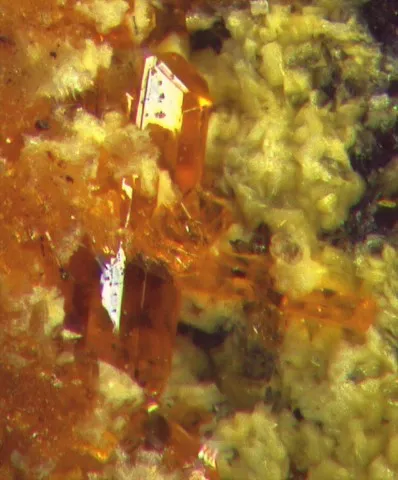RAMEAUITE
Class : Oxides and hydroxides
Subclass : Uranyl hydroxides
Crystal system : Monoclinic
Chemistry : K2CaU6O20 9H2O
Rarity : Very rare
Rameauite is an extremely rare hydrated oxide of uranium discovered during the exploitation of the Margnac uranium deposit (Haute-Vienne, France). It was observed in alteration zones at the periphery of uraninite nodules (pitchblende facies) and results from the first stages of transformation of this mineral. It was named in honor of Jacques Rameau, Prospector at the French Atomic Energy Commission (C.E.A.) who discovered the deposit where the mineral was found. Rameauite occurs in small tabular orange crystals reaching 1 mm, constantly twinned which gives them pseudohexagonal shapes. These crystals are flattened along {010} and elongated parallel to [001]. Rameauite appears in the company of other uranium oxides (becquerelite, schoepite, compreignacite, agrinierite, etc...), calcite, uranophane and of course uraninite.
Main photo : Rameauite from Margnac Mine, Compreignac, Haute-Vienne, France © Chuck Adan
Rameauite in the World
Twinning
Systematically twinned on {100}.
Fakes and treatments
No fakes listed for this mineral species.
Hardness : Undetermined
Density : 5.60
Fracture : Undetermined
Streak : Undetermined
TP : Translucent to transparent
RI : Undetermined
Birefringence : Undetermined
Optical character : Biaxial -
Pleochroism : None
Fluorescence : None
Solubility : -
Magnetism : NoneRadioactivity : Very strong

